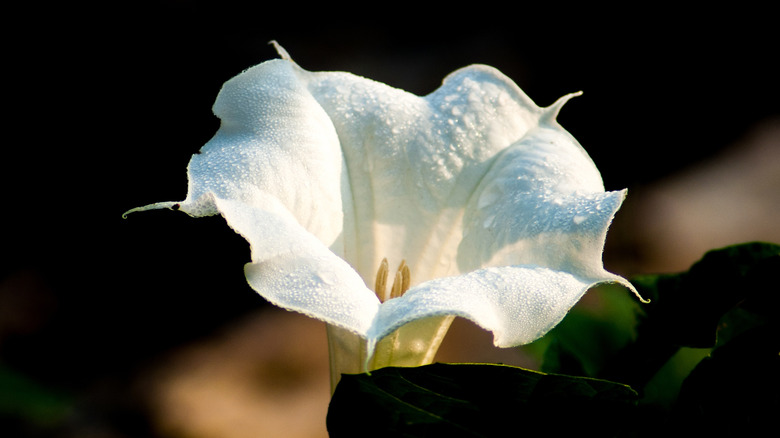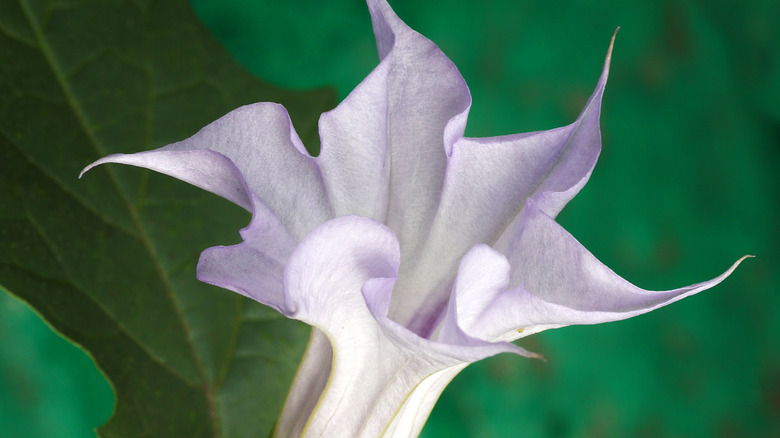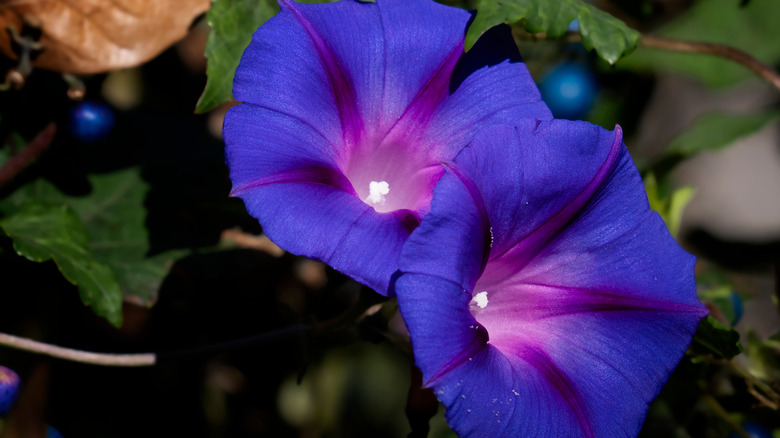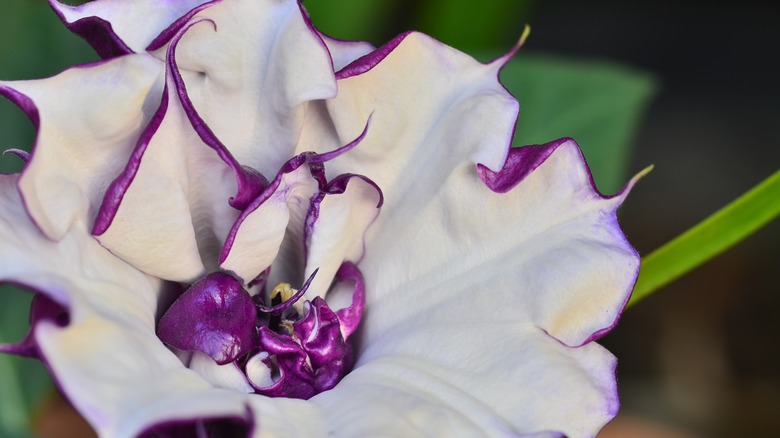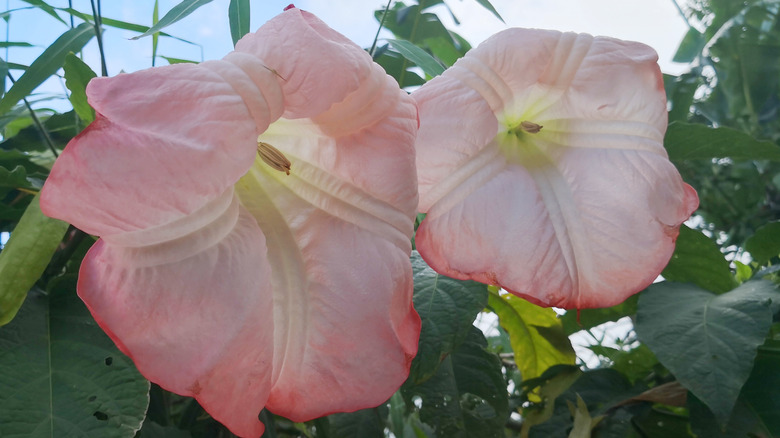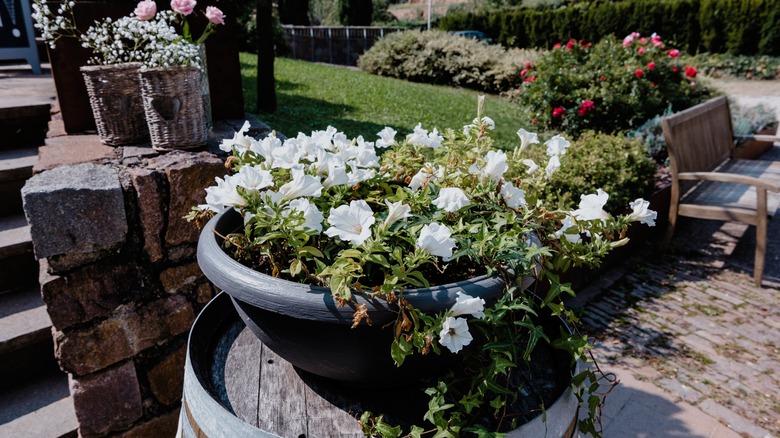How To Grow And Care For Datura Flowers
Like the femme fatales of film noir, the datura flower (Datura Stramonium) has a reputation as beautiful — and deadly. Known alternately as the devil's trumpet, thorn-apple, and moonflowers, these plants are native throughout North, Central, and South America. They're large, invasive, and poisonous. Fortunately, they're also easy to spot by their gray leaves and night-blooming bell-shaped flowers.
According to the Wisconsin Horticulture, their precise taxonomy is difficult to pinpoint because the plant has been naturalized throughout the Americas over centuries. However, it is often mentioned as a nuisance and called jimsonweed or mistakenly identified as Brugmansia (also known as the Angel Trumpet). How can you tell? Datura flowers reach skyward while Angel Trumpet blooms face down.
Daturas are herbaceous members of the stemmed nightshade family of plants known as Solanaceae (and are therefore related to eggplant, tomatoes, and peppers), and their checkered interactions with mankind harken back to Ancient Greece and India, where the daturas acquired both cultural and spiritual significance over time. Their seeds' hallucinogenic properties contribute to their mystique, too, and because they're poisonous, they're often mentioned in the same breath as nightshade and mandrake. In fact, daturas' seductive lure as a love potion has brought many a star-crossed romance to an early and tragic conclusion.
How to use datura flowers in the garden
Despite being poisonous, there is a reason gardeners can't swear off the addictive datura: they're strikingly attractive and can be showstoppers in nearly any setting. Their trumpet-like blooms open at dusk (hence their nickname as moonflowers) and often under overcast conditions. While unfurled, they give off an intoxicating lemon scent until dawn arrives, and they curl up again. Daturas range between 6 and 8 inches in diameter and appear in dynamic hues of yellow, lavender, red, and purple.
Ask the florists at Gardening Know-How, and they'll tell you that datura vines will take your affection and run wild with it since they're annuals that aggressively self-seed and reach adulthood — meaning between 10 and 20 feet long — over the span of a single season. Furthermore, because they're so easy to grow from seed, you'll have a problem with these plants you might not expect: they can and will overrun your garden if you don't take measures to keep them confined to the space you've allotted. For this reason, as beautiful as they are, they're also considered on a par with weeds because these plants simply won't stop repopulating once they've found a welcoming spot to thrive.
How to grow datura flowers
It's possible to propagate daturas from stem cuttings, but that's doing things the hard way. Because the plant is proactive in self-seeding, you can simply transplant the ones that sprout from seeds dropped by the parent plant — or grow them from seed yourself. The Spruce advises that you carefully remove seedlings (typically found where a mature plant deposited seeds the preceding year), using extra caution not to interfere with the seedlings' delicate root system, and move them into pots where they are safe from the harsh wintertime elements. Remember that these plants grow vines and will require a trellis or something similar to climb.
If you're starting from seeds you've collected from a seed pod, be certain they're completely dry. You should start your seeds indoors a month to a month and a half before the last expected frost occurs in your area. Before planting, you'll want to soak your seeds overnight or carefully crack their hard shell with a sharp object. Using a mix of seed starter, plant them a quarter-inch deep in well-draining containers (pots that are biodegradable will allow you to place them in the garden when the weather warms up and skip over transplanting), and give them indirect but bright sun. The soil should be warm and kept slightly moist until seedlings are visible. As the seasons change, give them longer exposure outdoors every day until after a week, when they are acclimated enough to be planted in your garden.
How to care for datura flowers
In cooler climates, you'll want to pull daturas out of the ground once their flowers have completed their season of blooms. Make sure you do so because leaving vines also leaves untold numbers of "volunteer" seeds behind — and that's a recipe for losing control of your garden. Also, always keep in mind that these plants are toxic even to the touch, although unlikely to be fatal. So you'll want to wear heavy gloves whenever you're handling them.
According to the experts at DIYS, daturas can be seen in a wide variety of places in the wild, growing without any assistance whatsoever. But if you want to maximize the size, quality, and quantity of your blooms, a little help goes a long way. Datura plants thrive in heat and do especially well with indirect sunlight, so watering them regularly and occasionally treating them with a phosphorous-rich fertilizer will get you some spectacular results and a higher quantity of blooms as well.
Early on, while your plant is growing at a rapid rate, it's going to be thirstier, so you should be watering it daily. Once you're sure it's gotten a solid foothold, you can actually regulate how fast the plant grows by watching your watering habits. Cut back to three times a week or so, depending on how the plant reacts. You will also want to irrigate in the morning so that the plant has ample time to absorb water before settling into the heat of the day.
Varieties of datura flowers
The florists at Garden Guides will tell you that there are close to a dozen (give or take) varieties of datura, and they share the trumpet-shaped blooms that gardeners, lovers, and mystics all find so irresistible. Devil's Trumpet (Datura Metel), for example, hails from Southeast Asia and is also known as the horn of plenty. This particular variety does also emit an aroma, although not a pleasant one. It's recognized by white flowers frosted at the tips with purple. Some other well-known varieties include:
Jimsonweed (Datura Stramonium), also nicknamed the "zombie's cucumber" and Angel's Trumpet (Datura Innoxia) — both familiar to the Aztecs as Tlapatl and Mixitl. respectively.
Researchers at Science Direct trace moonflowers back to 1596, when an herbalist named Li-Shih-Chen wrote about the Man-t'-o-lo plant and it's believed powers to heal. At the time, both seeds and flowers were used in combination with wine and cannabis as an anesthetic, as well as to treat facial rashes and neurological maladies. Among the lesser-known species, both Datura Ferox and Datura Ceratocaula are also known to cause hallucination.
How to repot datura flowers
When it comes to repotting any of your datura plants, it can't be emphasized enough that you need to protect yourself against the plant's toxins. Hallucinations (or worse) can result from handling any part of the plant, especially if you inadvertently open it.
Home Guides says to start by selecting a new home site — someplace with partial shade or direct sunlight. You'll want a container of compost, sphagnum peat moss, aged manure, or pine bark humus mixed at least ten inches deep alongside your soil, leaving a hole double the size of your plant. Make sure your datura is well watered (two or three gallons' worth) between 24 and 48 hours before transplanting.
Next, trim your daturas to between 6 to 12 inches. When you pick up a shovel, make sure you are at least a foot from the plant when you dig, you won't cut through its roots. When you've done this twice, or three times, you should be able to extract the plant — base, roots, soil, and all. Do not remove the soil.
Place the plant at the same depth as it was in its previous home and backfill. Add water (two gallons or so) to acclimate the plant. Organic mulch will help, as will additional water (two or three gallons three times a week, depending on the plant), and keep the soil moist. After the first year, you can pare back to a single watering per week.
